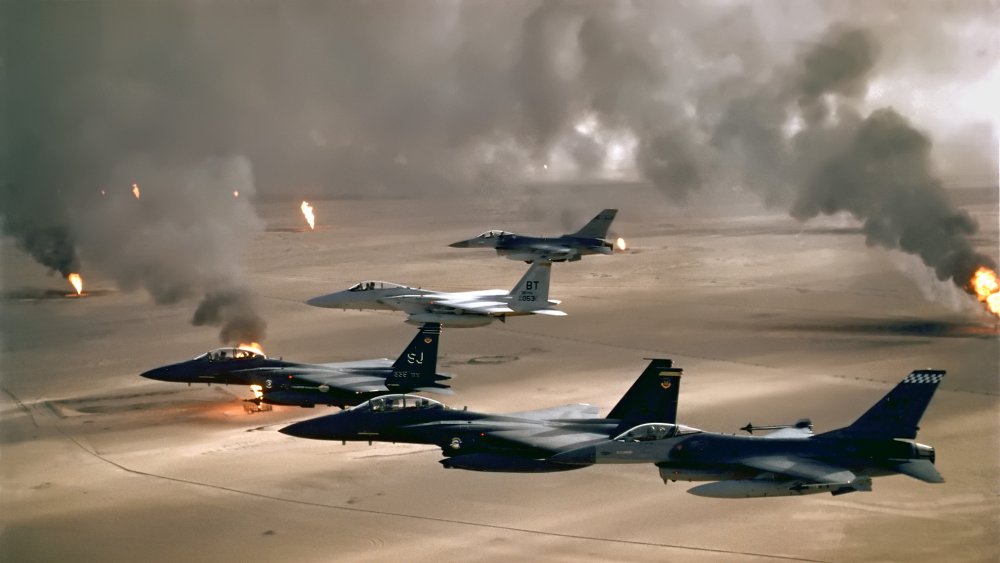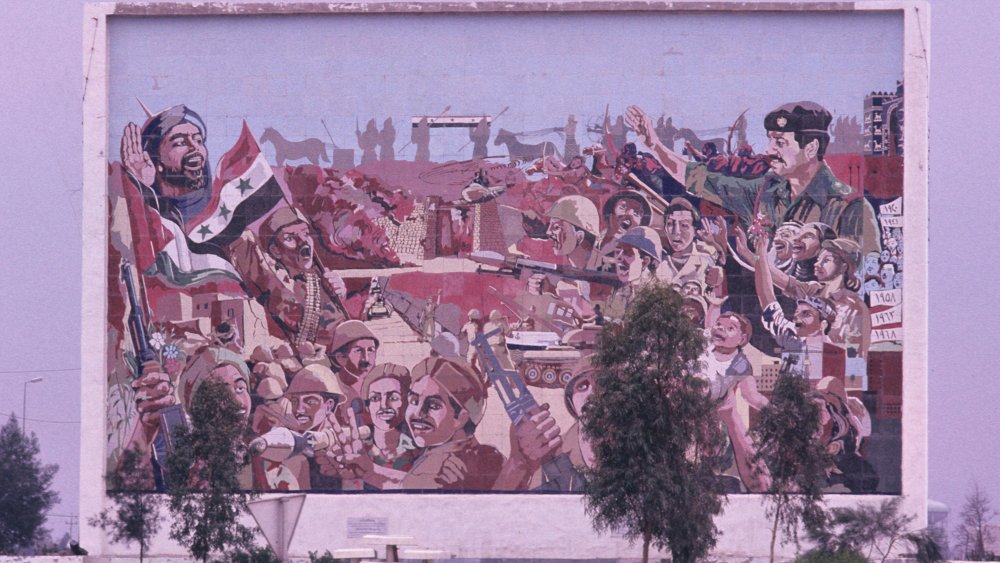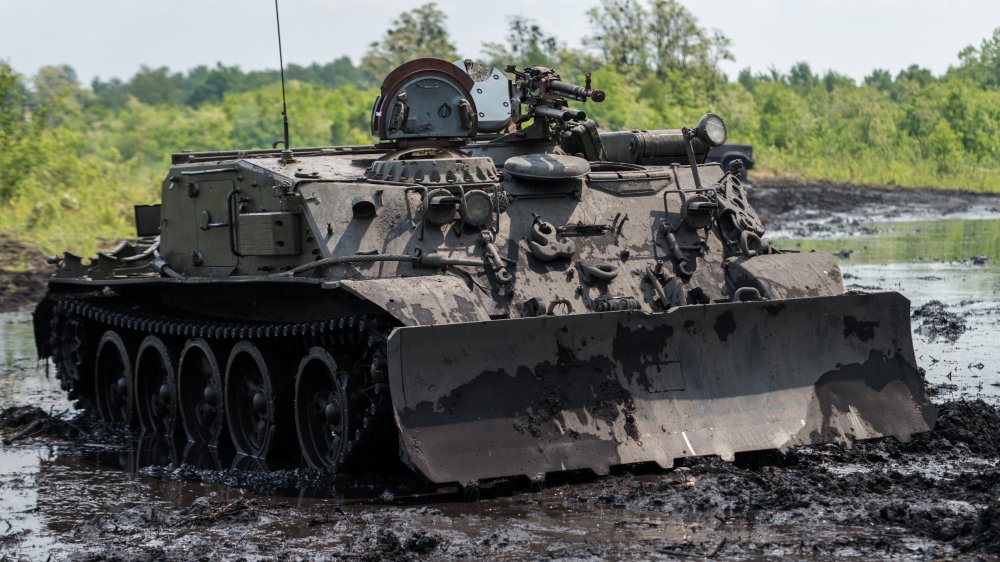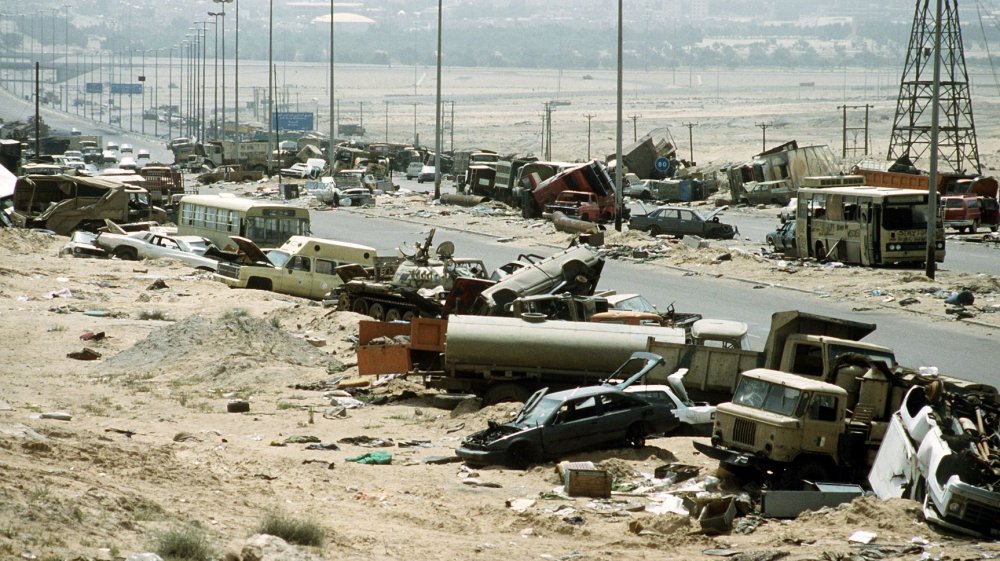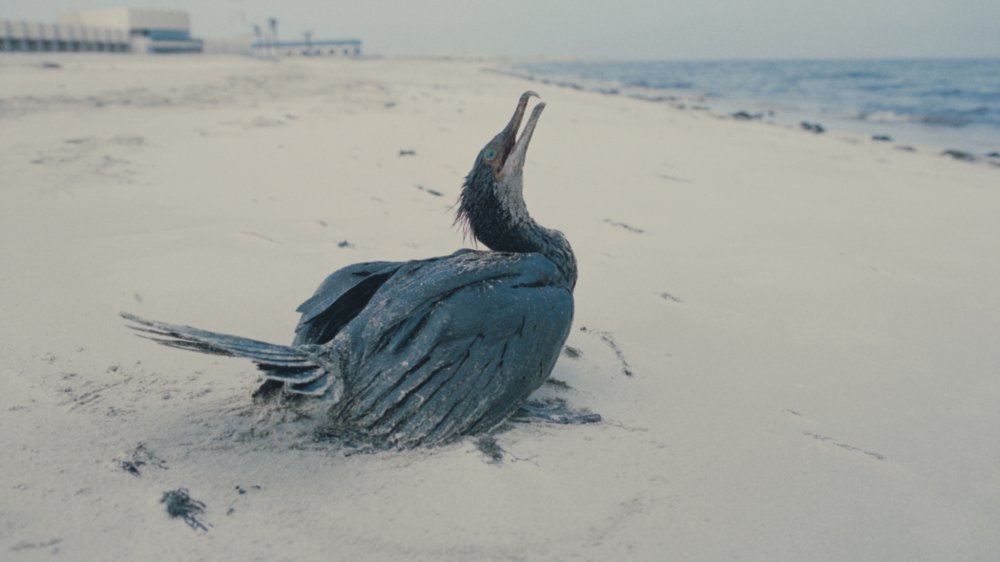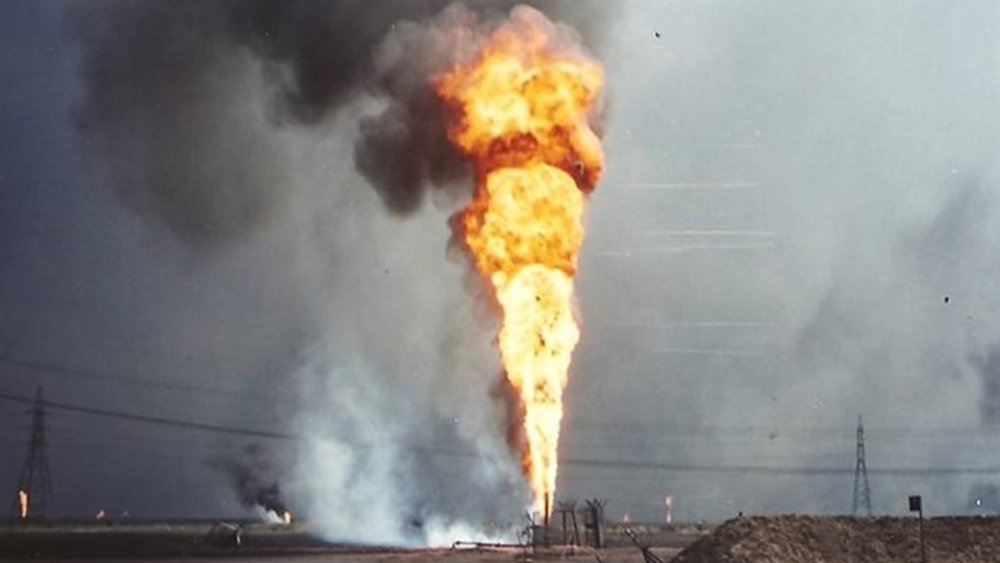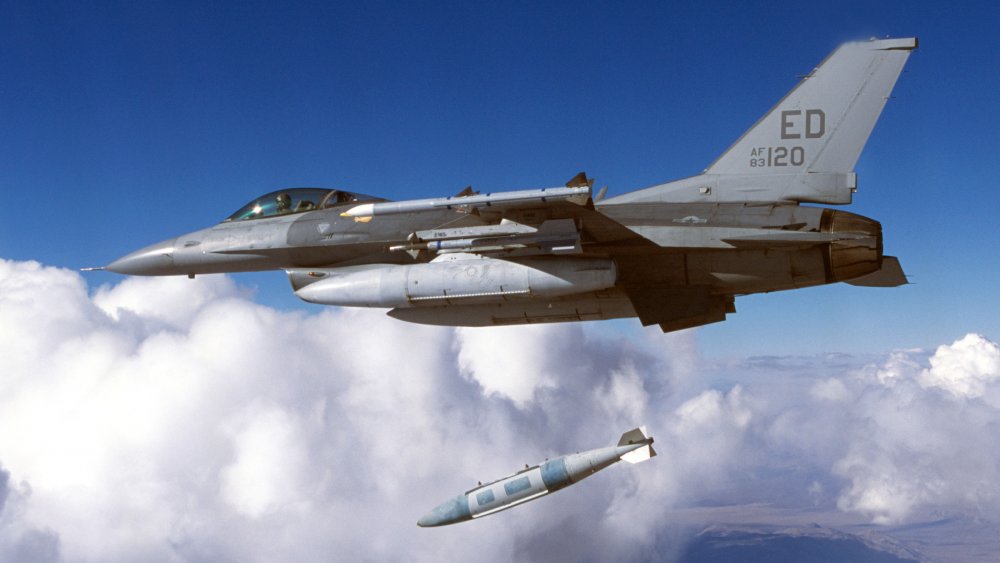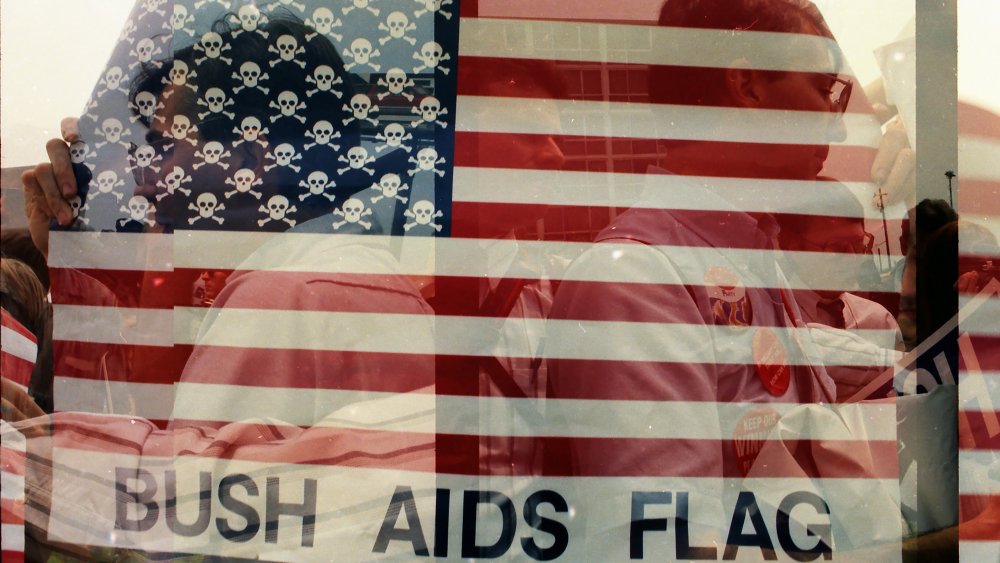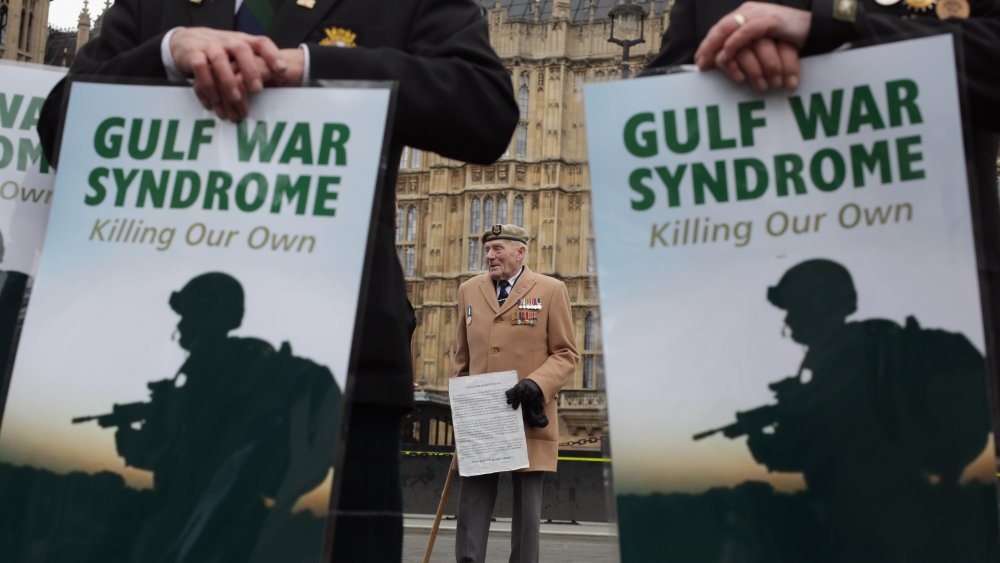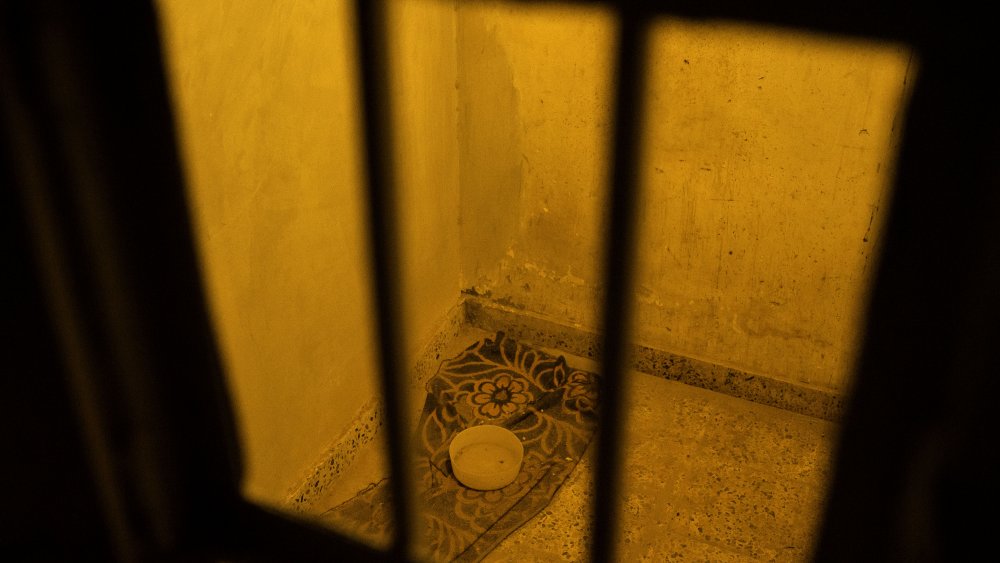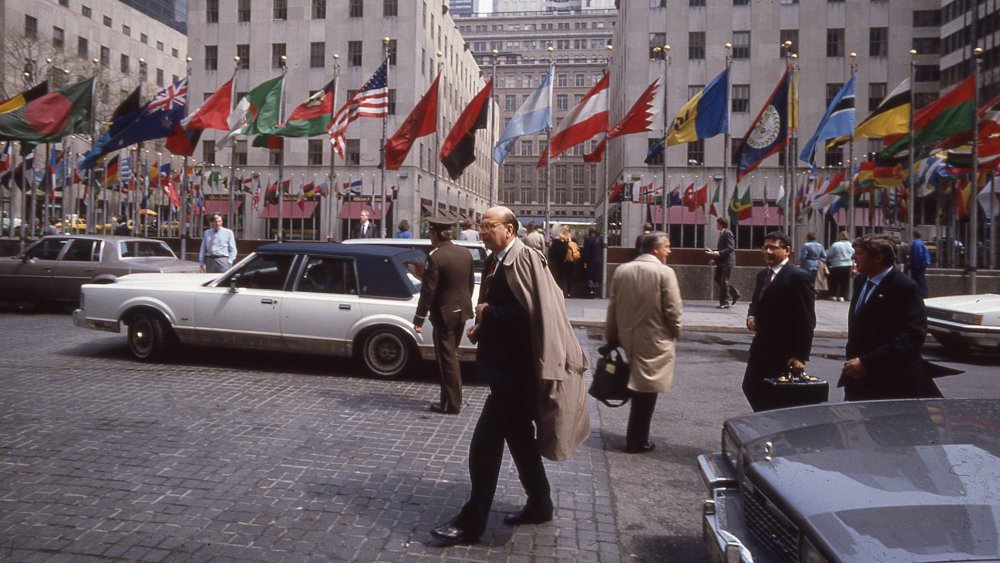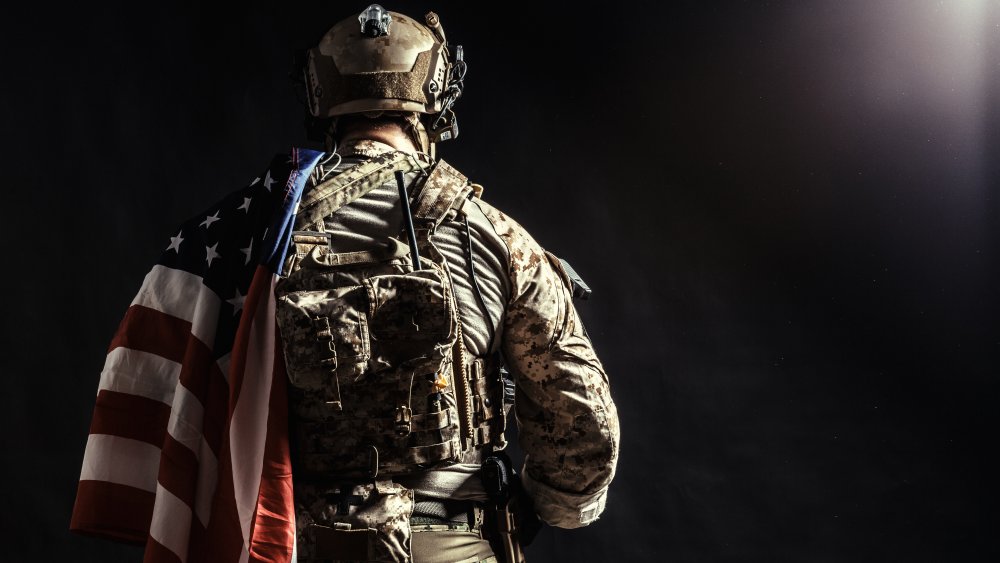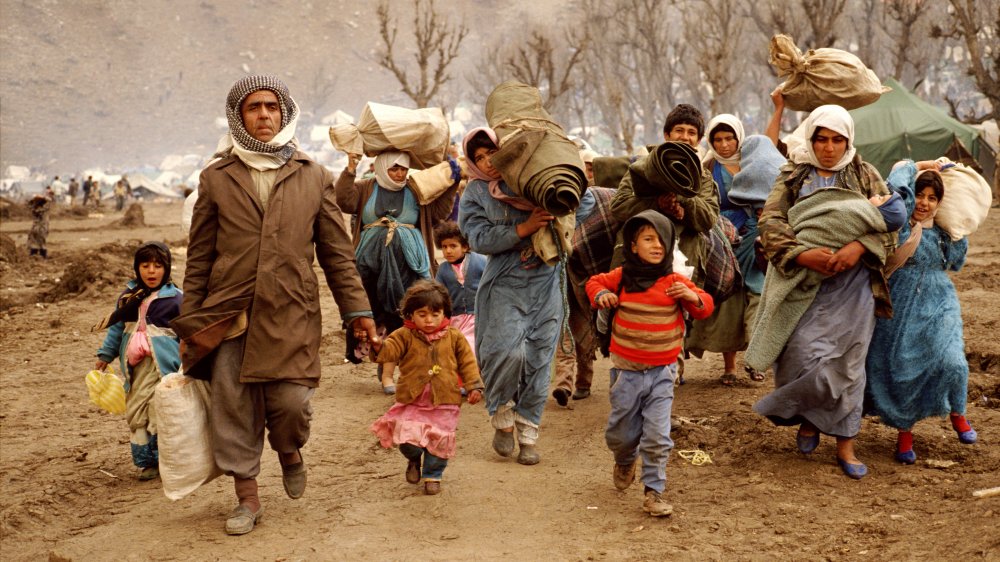Messed Up Things That Happened During The Gulf War
Warfare is often an incredibly messed up affair, and the Gulf War is no exception. Also known in the United States as Operation Desert Storm, the Gulf War started when Iraq invaded Kuwait on August 2, 1990. While there are a number of causes that can be attributed to the start of the Gulf War, oil was by and large one of the most central issues of the conflict.
Iraq was given a deadline of January 15, 1991, to pull out of Kuwait, and when they showed no intention of withdrawing, the United States started their air offensive. By the time ground troops from the US-led coalition started their offensive, Iraqi troops had already begun to retreat, and the ground war lasted less than a week.
Despite the fact that the war was comparatively shorter than most, countless atrocities were perpetrated by both sides. Some consequences of the Gulf War, such as Saudi Arabia allowing US troops to maintain a presence in the country, would ripple out and lead to further conflict in the following decades. As a result of more recent conflicts in the region, the Gulf War is often overlooked. However, its horrors continue to haunt its victims to this day. These are some of the messed up things that happened during the Gulf War.
The United States provoked Iraq
Although the cause of the Gulf War is attributed to Saddam Hussein's invasion and occupation of Kuwait, the seeds of the war were sown long before the first troops marched into Kuwait. According to the International War Crimes Tribunal, the United States had a pattern of instigation, intending to provoke events that could justify US involvement.
As reported by Reuters, OPEC was already concerned about Kuwait's excess oil output in 1989. Despite the quotas instituted by OPEC, Kuwait decided to be in charge of their own oil production and began producing upwards of two million barrels per day. Due to this overproduction, Iraq was unable to recover lost revenue from the years spent at war with Iran. When asked by Iraq to decrease their oil production, Kuwait refused, which was seen by Iraq as an act of aggression.
Meanwhile, the United States was aware of these disputes and was benefiting from the falling price of oil, and although the Bush administration was warned that aid to Iraq was being used to buy weapons, they continued to supply Iraq with aid and loan guarantees. Right before the invasion, Saddam Hussein asked US ambassador April Glaspie what the United States' opinion on Iraq's claim to Kuwait was. Glaspie replied that, "We have no opinion on your Arab-Arab conflicts [...] the Kuwait issue is not associated with America." While Glaspie would later say that the United States never thought Iraq would invade Kuwait, it seems that they did little to dissuade Iraq.
Assault by bulldozer
On February 25, 1991, three days before the Gulf War would be declared over, the United States engaged in what would become known as the "bulldozer assault." In order to break through the Iraqis' defensive line, the US Army mounted plows onto their tanks to drive over the trenches and bunkers. According to The Seattle Times, more than 70 miles of trenches were initially being defended by more than 8,000 Iraqi soldiers. In the end, around 2,000 soldiers surrendered, and the rest had been buried, alive and dead, under the sand.
According to war correspondent Leon Daniel, when he arrived at the scene, it was noticeably different from other battlefields that he had encountered during the Gulf War, without any of the horrid smells typically associated with warfare. When he asked an Army major, "Where are the bodies?" the major simply replied, "What bodies?" The operation had also apparently been rehearsed, with the US Army practicing multiple times on a one-mile trench.
Colonel Lon Maggart estimated that around 650 Iraqi soldiers had been buried, while Secretary of Defense Dick Cheney acknowledged that at least 450 dead soldiers were buried during the war. With at least 6,000 soldiers missing, Colonel Anthony Moreno came closest in his estimation, admitting that, "For all I know, we could have killed thousands."
The highway of death
When Iraqi troops invaded Kuwait, they went down Highway 80. They used the same highway to retreat, and it was during this retreat that the highway gained its notoriety as the "Highway of Death." According to Atlas Obscura, as Iraqi troops began withdrawing from Kuwait on February 27, 1991, a US-led coalition began bombing the front and back of the military convoy, effectively keeping the troops trapped on the highway. It became a tragic irony that troops intended to drive Iraqi forces out of Kuwait ended up keeping them from leaving.
Iraqi troops had been given the order to leave on February 25 when Baghdad radio announced that a cease-fire proposal had been accepted. The following day, Saddam Hussein reiterated the orders, stating that troops had already begun to withdraw. President George H.W. Bush repeatedly called these claims a hoax, insisting that Iraqi soldiers were continuing to fight and that the war must go on.
Despite the apparent withdrawal, the US-led coalition began airstrikes during the night, dropping bombs indiscriminately. Military vehicles were hit, as were cars, buses, and trucks that belonged to Palestinian and Iraqi civilians, and casualties numbered over 1,000. According to The Washington Post, the massacre became the focus of a PR campaign as the United States sought to justify what was essentially a violation of the Geneva Conventions, which states that attacking soldiers who are withdrawing is a war crime.
An intentional oil spill
The world had already witnessed a catastrophic oil spill in 1989, after the Exxon Valdez supertanker accidentally hit a reef and spilled 11 million gallons of oil off the coast of Alaska. Less than two years later, the world watched as the catastrophe of an oil spill was harnessed as a weapon. During the Gulf War, Iraq is said to have released two to ten million barrels of oil into the Persian Gulf.
According to the Chicago Tribune, the spill threatened various water desalination plants in both Saudi Arabia and Kuwait, and some speculated that the oil was meant to prevent any landing by US-led coalition forces. And according to the Saint Louis-Warsaw Transatlantic Law Journal, these actions by Iraqi soldiers are considered war crimes due to their environmental devastation and pollution of water sources.
In 2005, the International Oil Spill Conference published a study regarding the effects of the oil spill, claiming that the intentional spill continues to have toxic effects on the area. Estimates say that millions of cubic meters of oil remain on the shoreline, and ecological recovery remains low, especially in areas with little wave activity, which results in buried and stagnant oil.
Setting fire to oil wells
While Kuwaiti oil wells had already been targeted during the war, in the conflict's final days, Iraqi soldiers amped up their assault, resulting in roughly 600 oil wells being set on fire, some of which would continue to burn for many months after.
The burning of the wells was part of Saddam Hussein's scorched earth policy, planning to leave nothing in his wake as his soldiers literally scorched the earth. According to The Gulf War Aftermath, between 1.2 and 7.5 million barrels burned per day, with a total emission of over one billion barrels of crude oil. This affected not only Kuwaiti oil production but also had devastating health and environmental effects.
Even after the fires were extinguished, there were hundreds of oil lakes remaining since some of the wellheads had gushed without igniting. These lakes threatened migrating birds as well fresh water sources, with one report claiming that the oil lakes covered 60 percent of the desert. There was also a great deal of soot and oil in the sky. Due to the polluted air, outbreaks of respiratory and skin disorders began to afflict the local population, and hundreds of animals died as a result of breathing the oily air. And as the soot and oil came to rest on the sand and gravel, they combined to create a layer of "tarcrete" that, according to NASA, covers almost five percent of Kuwait.
Let the bombs fall where they may
During the Gulf War, there was little to no precision, despite the fact that the Pentagon frequently boasted of their precision bombing. While precision-guided bombs were certainly being used, they only accounted for about eight percent of the total tons dropped. This was in stark contrast to President Bush's assurances that the bombing was "fantastically accurate."
The rest of the unguided bombs, according to The Washington Post, missed 70 percent of the time. Air Force general Merrill A. McPeak reported that compared to the 26,363 tons of bombs that hit their targets, 62,137 tons missed. While the notion of unguided bombs missing their targets was hardly new in warfare, it seriously conflicted with how the United States was portraying their supposedly technologically advanced and accurate engagement. It was also well-known among military officials that the bombs typically didn't hit their targets, as General John M. Loh, head of the Tactical Air Command, acknowledged that the bombs were used with the knowledge that at least half would miss.
Unfortunately, this large margin of error might help account for the staggeringly high civilian death rate that occurred during the Gulf War.
Americans died, but not in the war
Before the Pentagon undertook Operation Desert Storm, press reports suggested that they were preparing for upwards of 30,000 American casualties. Their estimates ended up being drastically far off, at least in regards to the cause of death.
During the Gulf War, fewer than 400 Americans died in the theater of war, with less than half of those deaths being in combat. At the same time, the United States was in the midst of the HIV/AIDS crisis as deaths increased from the 1980s to the 1990s. According to the CDC, in 1991, almost 30,000 people in the US died from HIV, which averages out to roughly 2,500 a month. This means that during the Gulf War, far more Americans died from HIV/AIDS than from the conflict itself.
Casualties on the other side were also disproportionate, with estimates ranging from 10,000 to 100,000 Iraqi soldiers killed and 100,000 to 200,000 civilian casualties. These numbers are disputed, since some scholars base their estimates on the number of bodies found, although considering that the United States used tactics that led to thousands of bodies being buried, like the bulldozer assault, the true number of non-American casualties will never be known.
Gulf War syndrome
Although few Americans died in the war itself, many came back suffering from strange symptoms that became known as Gulf War syndrome. According to the US Department of Veterans Affairs, when soldiers came back from the Gulf War, many suffered from a series of inexplicable chronic symptoms including dizziness, insomnia, joint pain, headaches, fatigue, and respiratory disorders. In 2014, the Institute of Medicine released a report which stated that approximately one third of Gulf War veterans suffered from Gulf War syndrome.
According to the BBC, when veterans first started reporting symptoms, the government claimed that it was psychosomatic. While initially speculated to be a stress-related condition like PTSD, research shows that Gulf War veterans have comparatively lower levels of PTSD. Additionally, Gulf War syndrome appears to be limited to Gulf War veterans, since neither veterans from 1990s Bosnia nor veterans from 2000s Iraq and Afghanistan have shown signs of Gulf War syndrome.
One theory was that Gulf War syndrome was caused by depleted uranium in tank shells that the troops might have been exposed to, although this was disproved when it turned out that even soldiers with no history of exposure suffered from Gulf War syndrome. Another theory blamed the smoke from oil well fires, but the Presidential Advisory Committee on Gulf War Veterans' Illnesses concluded that this was unlikely. An additional theory blames exposure to the pesticides that were being used at the time, which explains a greater majority of the symptoms.
Torture by Iraqi soldiers
During the Gulf War, there were multiple reports of torture perpetrated by Iraqi soldiers on Kuwaiti and American prisoners. According to Al Jazeera, resistance fighter Saad Hamdan Sharar al-Khatlan was held in a Kuwaiti zoo for two weeks, where they removed his fingernails and shocked him with electric wires. Some of the torture also took place in Iraq's infamous Abu Ghraib prison, though his life was spared when Red Cross workers freed him in March 1991.
Kuwait's minister of state for cabinet affairs Abdul Rahman Al-Awadi estimated that during the Gulf War, as many as 20,000 people were taken as prisoners to Iraq to serve as slave labor. Doctors would also encounter mutilated corpses with body parts missing, such as eyeballs or even brains. According to the University of Baltimore Law Review, Kuwaiti prisoners and Iraqi civilian detainees suffered abuses ranging from acid baths to gang rapes to torture with electric drills.
American soldiers taken as POWs also experienced a variety of torture, including beatings and electrocution. According to The Guardian, in 2003, 17 POWs sued Saddam Hussein and were awarded nearly $1 billion in compensatory and punitive damages for their experiences as prisoners of war. The United States had seized Iraqi assets, and while the POWs assumed that they would pay out the settlement, the US insisted that the money belonged to the government and would be used on Iraqi reconstruction. The United States would later overturn the decision and toss out the award.
Support for the Gulf War through coercion and bribery
While the US-led international coalition during the Gulf War gave the impression that there was worldwide support for military intervention, the United States actually got the international community to abide by the Gulf War through coercing them to vote for the UN resolution that would legitimize the conflict.
According to the Institute for Policy Study, the United States was able to gather support for intervention through a series of bribes, such as dropping trade sanctions and approving new loans for China, promising the Soviet Union silence on repression in the Baltics, and promising aid to Colombia and Zaire. Yemen initially opposed the war, and the US threatened to cut off a $70 million-per-year aid package if they voted against the UN resolution. Yemen's aid was cut off when they voted against the resolution, while China maintained their deal by abstaining from the vote.
While there was support from European allies, the majority of soldiers on the ground were American, which was demonstrative of the European countries' desire to find a solution without military intervention.
Rape in the ranks
During the Gulf War, there were many instances of US military personnel being raped by their fellow soldiers. While a majority of the assaults were against women, men also reported sexual assault during their time in the Gulf War. According to a study by researchers for the Department of Veterans Affairs, during the Gulf War, eight percent of female soldiers suffered rape or sexual assault. Another study by the Department of Veterans Affairs that focused on male soldiers found that 0.2 percent reported sexual assault during the conflict, a figure which correlates to the rates of sexual assault reportage among civilians who are men.
According to The Washington Post, US Army records show reports of at least 24 Army servicewomen who were sexually assaulted or raped while serving, with the assaults often being committed by higher-ranking personnel. Few reported cases of rape reached a court-martial, and even when they did after repeated efforts, like in the case of Jacqueline Ortiz, the rapist was allowed to return to active duty while awaiting trial.
A promise is not a promise
Toward the end of the Gulf War, the Bush administration encouraged an uprising in Iraq, stating that it'd be possible for bloodshed to end if "the Iraqi military and the Iraqi people take matters into their own hands to force Saddam Hussein, the dictator, to step aside." This was taken by many not only to be a call for an uprising but an assurance from the United States that if such a revolution were to occur, there would be assistance from the US. As both Shiite Muslims in the south and Kurdish people in the north revolted, the Bush administration changed their tune and decided that it was best not to interfere.
When aid didn't come and the uprisings were violently suppressed, the empty promise of the United States was never forgotten. According to the BBC, many felt betrayed by America, which had seemingly appeared to endorse a popular rebellion that would oust Saddam Hussein. The US, meanwhile, would continue to insist that it neither wanted to intervene in the region's affairs nor desired to remove Saddam Hussein from power.
According to Smithsonian Magazine, it's unclear how many Shiites were killed in the uprising, but estimates are in the tens of thousands, with mass graves being periodically discovered. Kurdish people also suffered violent repression and displacement, with as many as two million refugees being forced out of towns and into the mountains.
